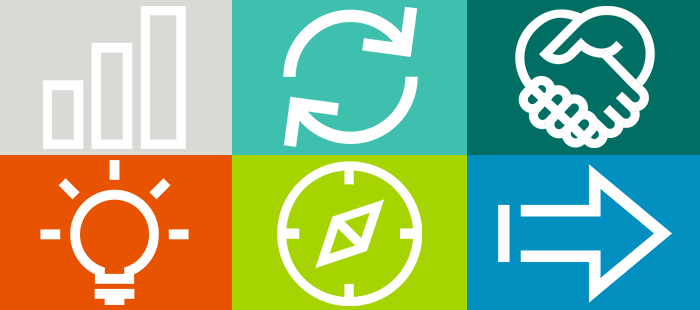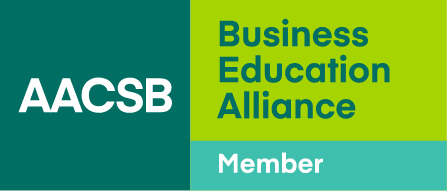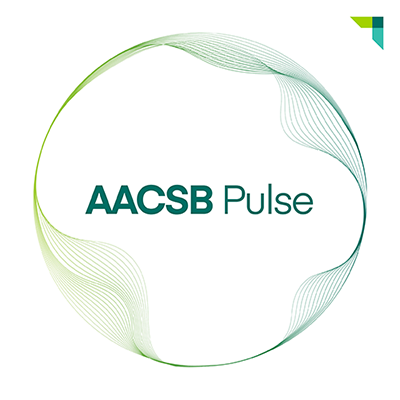Research Roundup: October 2025
In this issue: balance boosts performance, AI inspires creativity, urgency shapes sales, persuasion builds trust, and ethics drive a greener legacy.
Dive into our monthly Research Roundup, showcasing the latest insights from the business education community to keep you informed of new and noteworthy industry trends. Here are this month’s selections:
Boundaries That Improve Performance
- Researchers: Eileen Aitken-Fox and Steve McKenna, Curtin University
- Output: Quarterly Australian Work Outlook, Australian HR Institute, 2025
- Overview: Few policies have captured Australia’s workplace mood quite like the right to disconnect. As boundaries between work and personal life blur, this new law is prompting organizations to reconsider how they define the limits of availability and respect for employees’ time. Introduced in August 2024 for larger employers, the legislation allows workers to refuse work-related contact outside of standard hours unless refusal is unreasonable.
The Australian HR Institute’s June 2025 Quarterly Work Outlook set out to understand how this reform is influencing workplace culture, productivity, and well-being. Drawing insights from 619 senior HR and business leaders across sectors, the report examined how organizations are adapting to the change and whether the policy is meeting its goal of improving employee engagement and balance. - Findings: The report found that the right to disconnect has delivered mostly positive outcomes across organizations, particularly in public-sector workplaces. Fifty-eight percent of employers reported that the policy significantly or somewhat increased employee engagement and productivity, and 75 percent of public-sector employers observed similar gains. Just 4 percent of organizations experienced declines in these areas. Beyond performance metrics, 39 percent of employers said the law improved employees’ work-life balance, while 37 percent noted mostly positive changes in employee stress levels.
However, the transition has not been without challenge, as 38 percent of organizations reported resistance from middle managers, rising to 47 percent among large employers. Even so, the legislation caused little disruption, with only 10 percent of respondents saying it affected communication outside regular hours, and nearly half reporting it improved their ability to handle urgent or time-sensitive matters.
Overall, these findings suggest that implementation is progressing steadily, and early results point to stronger engagement, better balance, and modest cultural adjustments across Australia’s workplaces.
The AI Boost We Didn’t Expect
- Researchers: Taly Reich, New York University; Jacob Teeny, Northwestern University
- Output: “Does Artificial Intelligence Cause Artificial Confidence? Generative Artificial Intelligence as an Emerging Social Referent,” Journal of Personality and Social Psychology, 2025
- Overview: Imagine that a clever joke or striking painting produced by artificial intelligence made you feel more creative yourself? A recent study examined how exposure to AI-generated work influences people’s confidence in their own creativity. The research drew on social comparison theory, which explains that individuals evaluate their abilities by comparing themselves to others whom they see as similar.
When people perceive others as less skilled, they experience what psychologists call a downward comparison, which tends to increase self-confidence. The study proposed that AI now serves as a new kind of comparison target—something that seems human enough to invite comparison yet widely seen as less capable of imagination. The goal was to determine whether this comparison could raise people’s belief in their creative potential and affect their motivation to engage in creative work. - Findings: Across several experiments, participants consistently reported higher confidence in their creativity when they believed that AI, instead of a human, had produced work. In one test, hundreds of participants rated the same joke about an antidepressant pill. When participants were told in advance that a joke had been written by AI, they rated the writer’s humor 16 percent lower and felt 15 percent more confident in their own ability to write a better joke than those who believed a human had written it. The same trend appeared when participants viewed drawings, poems, and short stories, suggesting that identifying AI as the source reliably boosted self-assurance.
However, independent evaluators found that participants’ actual creative performance did not improve. The study concludes that AI functions as a “semi-human” comparison point that triggers downward comparison, raising confidence without enhancing skill.
For business leaders, these results suggest that showing AI-generated examples in creative sessions can boost team confidence and participation, creating a stronger foundation for creativity even when skill levels stay the same.
Too Much Urgency Can Cost the Sale
- Researchers: Ashesh Mukherjee, McGill University; Seung Yun Lee, Konkuk University at Seoul; Andrew Gershoff, The University of Texas at Austin
- Output: “Consumer Flexibility and the Effectiveness of Limited Time Offers: The Role of Psychological Reactance,” Journal of Business Research, 2025
- Overview: Can a countdown clock make customers walk away? Researchers explored when limited-time offers, those “today only” deals meant to spark quick purchases, work against a brand. While these promotions are often used to drive urgency, the team questioned whether they might backfire when people feel pressured or deprived of choice.
Grounded in psychological reactance theory, which explains how individuals push back when their freedom feels restricted, the researchers examined four types of consumer flexibility: purchase timing, store layout, return policies, and personal time availability. Their aim was to understand when these offers create value and when they instead reduce trust or enthusiasm toward the product - Findings: The findings revealed that time pressure can quickly turn motivation into resistance. In a campus study, 36 percent of students bought chocolates when the offer lasted one day, compared to 20 percent with no deadline, but only 5 percent when just an hour remained. Spending followed the same pattern, rising modestly with more flexibility and dropping when time ran out. Online experiments confirmed this trend: one-day limits improved evaluations but offers expiring within an hour or a minute lowered them as psychological reactance increased.
Other constraints produced similar effects. When shoppers could browse freely online, 63 percent chose the limited-time discount, but when the site forced a fixed path, that share fell to 42 percent. A flexible 30-day return policy made limited offers more appealing, while a “final sale” condition removed the benefit. Personal time mattered too: when participants imagined a relaxed day, one-day deals improved evaluations. However, during busier scenarios, they diminished them.
Finally, when the offer included a regret avoidance cue—“buy now or regret it later”—interest in a 30-minute deal increased compared to the same short offer without it. Overall, the results show that time limits drive engagement only when consumers retain a sense of flexibility in their decisions.
Convincing Customers to Click Yes
- Researchers: Caterina D’Assergio, Università di Bologna; Puneet Manchanda, The University of Michigan; Elisa Montaguti, Università di Bologna; Sara Valentini, Bocconi University
- Output: “The Race for Data: Utilizing Informative or Persuasive Cues to Gain Opt-In?,” Journal of Marketing, 2025
- Overview: In today’s race for consumer data, how firms ask for permission may matter as much as what they ask for. Researchers examined how companies across industries crafted their data consent messages under Europe’s General Data Protection Regulation (GDPR), which requires individuals to actively opt in to communications before their information can be used. The team analyzed 1,506 emails sent by 1,396 firms to uncover whether businesses rely on transparency, persuasion, or both to secure user consent.
Informative cues described how data were collected and managed, while persuasive cues emphasized benefits, rewards, or potential losses for noncompliance. The researchers then tested how these message formats influenced consumer response and what types of firms were most likely to choose each approach. Their aim was to reveal how organizations balance regulatory compliance with the desire to retain access to valuable customer data. - Findings: The analysis found that 26 percent of firms used only persuasive cues and another 24 percent blended persuasive with informative cues, while just 33 percent relied purely on information-based transparency. Persuasive cues included discounts, urgency, and benefit framing, such as BMW’s reminder that failing to opt in meant missing out on offers. Informative cues detailed how data would be stored and managed, as in National Geographic’s transparency-focused message. A field experiment with 14,078 prospective customers showed that messages combining both approaches significantly increased opt-ins, while purely informative ones did not. Consumers were especially responsive to persuasive cues offering monetary incentives, revealing a willingness to exchange data for financial rewards.
Firms with an offline presence or selling physical products were more likely to use persuasive strategies, whereas digital-only firms leaned toward informative messaging. The study also found that companies facing higher reputational risk from past data breaches avoided persuasion, while firms expecting greater benefits from data-driven advertising or cookie tracking were more likely to employ the technique.
For business leaders, these findings mean that message design is not only a compliance task but also a competitive one. Those who balance clarity with compelling incentives can strengthen both customer participation and trust.
Greener Generations of Business
- Researchers: Luis Gómez-Mejía, Arizona State University; Fernando Muñoz-Bullón, Universidad Carlos III de Madrid; Ignacio Requejo, Universidad de Salamanca; Maria J. Sanchez-Bueno, Universidad Carlos III de Madrid
- Output: “Ethical Correlates of Family Control: Socioemotional Wealth, Environmental Performance, and Financial Returns,” Journal of Business Ethics, 2025
- Overview: Can a family’s emotional bond with its business become an ethical advantage? Researchers examined more than 700 firms across Europe in highly polluting industries to understand whether family control influences how responsibly companies treat the environment. Their focus was on socioemotional wealth, which is the emotional value families place on their reputation, legacy, and community relationships, and how it shapes environmental and financial performance.
The study also explored whether these effects depend on who leads the company, such as family members serving on the board or founders still in charge. By relying on verified emissions data rather than company claims, the researchers aimed to reveal whether family businesses’ actions support their assertions when it comes to environmental responsibility. - Findings: Family-controlled companies were found to emit about 48 percent less pollution than non-family firms operating in the same industries. Those with family members on the board or still under first-generation leadership were the most proactive in implementing substantive pollution control and prevention measures. Firms with active family boards were more likely to take measurable steps to reduce emissions rather than rely on symbolic sustainability claims. The research also showed that these ethical actions did not hurt profits.
In fact, family firms benefited more financially from their environmental responsibility. Because family firms have stronger reputational and relational capital within the community, when they undertake substantive environmental improvements, they gain more stakeholder goodwill, which can lead to improved market access, better terms with lenders, stronger customer loyalty, and possibly lower regulatory or operational risk.
If you have new research from your school share with the business education community, please submit a summary and relevant links to AACSB Insights via our online submission form at aacsb.edu/insights/articles/submissions.






